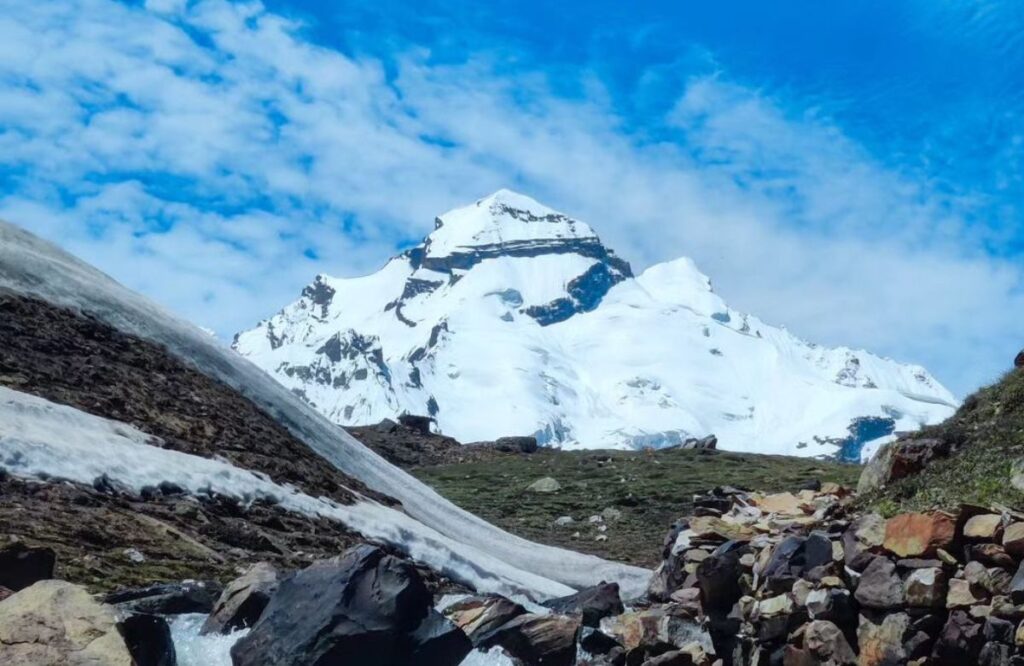The journey to Mount Kailash from Lipulekh epitomizes a spiritual odyssey of unparalleled significance. Nestled in the pristine landscapes of Uttarakhand, Lipulekh serves as the gateway to the revered Adi Kailash, a site steeped in Hindu mythology and spirituality. While the pilgrimage to Adi Kailash once entailed a grueling trek spanning several days, the recent construction of a motorable road has heralded a new era, promising greater accessibility and ease for pilgrims embarking on this sacred journey.
Mount Kailash from Lipulekh Pass, India
Situated adjacent to the India-Nepal-Tibet border, Lipulekh offers pilgrims a glimpse of the majestic Mount Kailash, a towering pinnacle revered by Hindus worldwide. Adi Kailash, standing at an imposing altitude of 5,945 meters, resides within the picturesque Pithoragarh district of Uttarakhand.
The route to both Adi Kailash and Kailash Mansarovar commences from Dharchula, with the paths diverging at Gunji. While Adi Kailash rests within Indian territory, Kailash Mansarovar lies across the border in Tibet, a region mired in geopolitical complexities.
Previously, the arduous stretch from Dharchula to Tawaghat necessitated travel by foot, a journey spanning 8-10 days. However, the advent of a motorable road has revolutionized the pilgrimage, rendering it accessible to a broader spectrum of devotees and significantly reducing travel time.
Furthermore, the construction of the road has catalyzed economic opportunities for local communities, offering employment prospects and bolstering infrastructure development in the region.
Near Adi Kailash, the base camp of the Army and Indo-Tibetan Border Police (ITBP) at Jyolingkong marks a pivotal juncture along the pilgrimage route. Approximately 40 kilometers from this base camp lies the tri-junction border between India, Tibet, and Nepal, beyond which civilian access is restricted.
Despite its spiritual significance, Jyolingkong boasts limited accommodation options, underscoring the rugged and remote nature of the terrain.
Legend has it that Adi Kailash is the sacred abode where Lord Shiva and Goddess Parvati once halted on their journey to Mount Kailash, bestowing upon it profound mythological significance. Even today, locals revere the site, believing in the existence of a Parvati temple where the goddess purportedly bathed, with a symbolic pond serving as a poignant reminder of this mythological narrative.
How to reach Lipulekh pass
To reach Lipulekh, follow these steps:
- Reach Pithoragarh: Begin your journey by reaching Pithoragarh, a town in Uttarakhand, India.
- Proceed to Dharchula: From Pithoragarh, travel to Dharchula, which serves as a gateway to the Lipulekh Pass.
- Obtain Permissions: Ensure you have obtained the necessary permissions from the Indo-Tibetan Border Police (ITBP) and the Sub-Divisional Magistrate (SDM) office in Dharchula before proceeding with your journey. These permissions are essential for accessing restricted areas and ensuring a smooth travel experience.
- Local Transportation to Gunji/Nabi: In Dharchula, you can find local transportation options to reach Gunji or Nabi, nearby villages en route to Lipulekh.
- Hire a Local Tour Guide: Upon reaching Gunji or Nabi, hire a local tour guide who can assist you in navigating the terrain and reaching your destination safely.
- Journey to Jyolingkong and Lipulekh: With the guidance of your tour guide, embark on the journey to Jyolingkong and subsequently to Lipulekh, soaking in the scenic vistas and spiritual ambiance along the way.

In conclusion, the pilgrimage from Lipulekh to Mount Kailash is not merely a physical journey but a spiritual odyssey imbued with profound significance and reverence. As pilgrims traverse the rugged terrain and immerse themselves in the divine aura of Adi Kailash, they embark on a transformative quest for spiritual enlightenment and divine blessings, forging an enduring connection with the sacred landscapes of the Himalayas.


